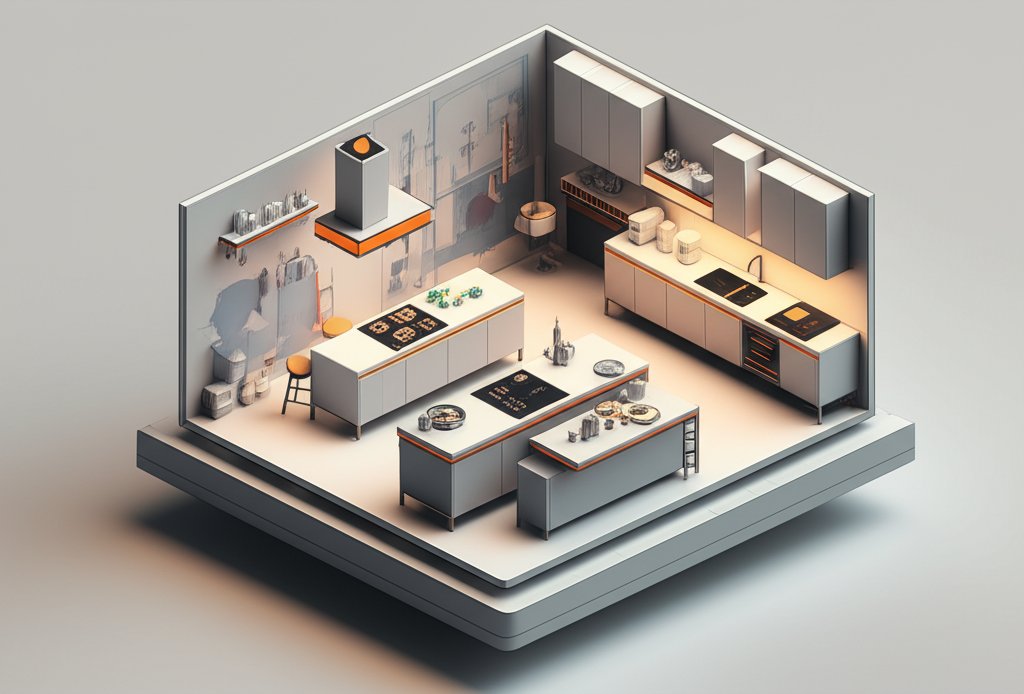Dreaming of a kitchen that’s both functional and a showstopper? Double island kitchens are gaining popularity, and for good reason. They offer a unique blend of practicality and style, maximizing workspace, storage, and social interaction. But is a double island kitchen right for you? Let’s explore the world of double island kitchen ideas and discover how to design the perfect cooking space for your needs.
At a glance:
- Maximize space and functionality: Double islands provide ample counter space, storage, and dedicated zones for cooking, prepping, and entertaining.
- Enhance social interaction: Create a gathering hub where family and friends can comfortably interact while you cook.
- Divide and conquer: Zone your kitchen effectively, separating prep areas from dining or work zones.
- Add visual interest: Break up the monotony of a large kitchen with two distinct islands.
- Consider your space: Double islands aren’t just for large kitchens; clever designs can work in smaller spaces too.
Why Choose a Double Island Kitchen?
A single, oversized island can sometimes feel monolithic and impractical. Double islands, on the other hand, offer a more balanced and functional approach. Think of it as dividing your kitchen into distinct zones, each with its own purpose.
- Increased Counter Space: Double the islands, double the space! This is a boon for avid cooks who need plenty of room for prepping, chopping, and assembling dishes.
- Separate Work Zones: Designate one island for food preparation, complete with a sink and cutting board, while the other serves as a breakfast bar, entertaining area, or homework station.
- Enhanced Storage: Double the islands means double the storage! Incorporate drawers, cabinets, and open shelving to keep your kitchen organized and clutter-free.
- Improved Traffic Flow: Two islands can create a natural pathway through your kitchen, preventing bottlenecks and making it easier for multiple people to move around.
- Social Hub: One island can be designed for cooking and prep, while the other acts as a place for guests to sit and chat while you work your culinary magic. After all, the kitchen is often the heart of the home!
Is a Double Island Kitchen Right For You? Considerations Before You Commit
Before you jump on the double island bandwagon, it’s crucial to assess your kitchen space and lifestyle. Here are some key factors to consider:
- Kitchen Size: This is the most obvious factor. You’ll need a spacious kitchen to comfortably accommodate two islands without feeling cramped. Remember to factor in adequate walkways.
- Layout: Consider the overall layout of your kitchen. Double islands work best in open-plan kitchens where they can effectively zone different areas.
- Functionality: How do you plan to use your kitchen? If you’re a serious cook who loves to entertain, double islands can be a game-changer. However, if you rarely cook, a single island might suffice.
- Budget: Double islands can be a significant investment, as you’ll need to factor in the cost of materials, installation, and plumbing (if you’re adding a sink or cooktop to one of the islands).
Double Island Kitchen Layout Ideas: Finding the Perfect Fit
There’s no one-size-fits-all solution when it comes to double island kitchen layouts. Here are a few popular configurations to inspire you:
- Parallel Islands: This is the most common layout, with two islands positioned parallel to each other. It works well in long, rectangular kitchens, creating a clear walkway between the cooking and entertaining zones. In fact, Double Island Kitchen Inspiration often features this configuration.
- Perpendicular Islands: This layout places one island perpendicular to the main kitchen counter and the other parallel to it. It’s a great option for L-shaped kitchens, as it creates a more defined cooking zone and a separate seating area.
- Staggered Islands: For a more unconventional look, consider staggering the islands at slightly different angles. This can add visual interest and break up the monotony of a symmetrical layout.
- One Large, One Small: If space is a constraint, consider one larger island for prepping and cooking and a smaller island for seating or serving.
Designing Your Double Island Kitchen: Key Elements to Consider
Once you’ve decided on a layout, it’s time to focus on the design details. Here are some key elements to keep in mind:
- Size and Proportion: The size of your islands should be proportionate to the overall size of your kitchen. Avoid islands that are too large, as they can make the space feel cramped. As H&G’s Editor in Chief Lucy Searle advises, “One of the mistakes to avoid with kitchen island design is installing units that are simple too large – two smaller kitchen islands are often much better than one very large one.”
- Height: Ideally, the islands should be the same height for a cohesive look. However, you can also consider different heights for different functions. For example, a standard 36-inch height is ideal for prepping, while a 42-inch height is perfect for a breakfast bar.
- Materials and Finishes: Choose materials and finishes that complement your existing kitchen decor. Consider using different materials for each island to create visual interest. For example, you could use a natural wood countertop for one island and a sleek quartz countertop for the other.
- Functionality: Think carefully about how you’ll use each island and incorporate features accordingly. This might include a sink, cooktop, dishwasher, wine fridge, or built-in storage.
- Lighting: Pendant lights are a great way to highlight your islands and provide task lighting. Choose fixtures that complement your kitchen’s style and provide ample illumination. Gary Singer, founder and creative director of , notes the importance of matched lighting above double kitchen islands, providing decoration, focus and unity.
- Seating: If you plan to use one of your islands as a breakfast bar, make sure to include comfortable seating. Bar stools with backrests are a good option for adults, while swivel stools are great for kids.
Making the Most of Your Double Island Kitchen: Functionality is Key

The beauty of a double island kitchen lies in its versatility. Here are some ideas for maximizing its functionality:
- Prep Zone: Designate one island as your primary prep zone, equipped with a sink, cutting board, knife block, and ample counter space.
- Cooking Zone: Install a cooktop or range on one of the islands to create a dedicated cooking zone. Be sure to include a range hood to vent fumes and odors.
- Baking Center: Transform one island into a baking center, complete with a stand mixer, rolling pin, and plenty of storage for baking supplies.
- Entertaining Area: Use one island as a serving station when entertaining guests, complete with a wine fridge, ice maker, and plenty of space for appetizers and drinks.
- Homework Station: Create a dedicated homework station on one of the islands, with comfortable seating, good lighting, and plenty of storage for school supplies.
Avoiding Common Double Island Kitchen Mistakes
While double islands can be a fantastic addition to your kitchen, it’s important to avoid these common mistakes:
- Insufficient Space: Ensure you have ample space to comfortably move around both islands. A minimum of 42 inches between islands and surrounding counters is recommended, but 48 inches is ideal.
- Poor Layout: Carefully consider the layout of your kitchen and how the islands will impact traffic flow. Avoid placing islands in areas that will create bottlenecks or impede movement.
- Lack of Functionality: Don’t just install islands for the sake of it. Make sure they serve a specific purpose and enhance the functionality of your kitchen.
- Mismatched Styles: Choose materials and finishes that complement your existing kitchen decor. Avoid using clashing styles or colors, as this can create a jarring effect.
- Inadequate Lighting: Ensure both islands are well-lit with task lighting and ambient lighting. Poor lighting can make it difficult to work in the kitchen and create an uninviting atmosphere.
Double Island Kitchens in Smaller Spaces: Making it Work
Think you don’t have enough space for a double island kitchen? Think again! With some clever design tricks, you can make it work even in smaller kitchens.
- Long and Narrow Islands: Opt for long, narrow islands instead of bulky, square ones. This will maximize counter space without taking up too much floor space.
- Mobile Islands: Consider using one or two mobile islands that can be easily moved around as needed. This is a great option for smaller kitchens where you need flexibility.
- Multi-Functional Islands: Choose islands that serve multiple purposes. For example, one island could be used for prepping and cooking, while the other could double as a dining table.
- Vertical Storage: Maximize vertical storage with tall cabinets, open shelving, and hanging pot racks. This will free up valuable counter space and make your kitchen feel more spacious.
Double Island Kitchen Ideas: Inspiration Gallery
Looking for some visual inspiration? Here are a few double island kitchen ideas to get your creative juices flowing:
- Modern Minimalist: Sleek white islands with quartz countertops and stainless steel appliances.
- Rustic Chic: Wooden islands with butcher block countertops and farmhouse-style sinks.
- Coastal Cottage: Light and airy islands with shiplap siding and pastel-colored accents.
- Industrial Loft: Concrete islands with metal accents and exposed brick walls.
- Traditional Elegance: Dark wood islands with granite countertops and ornate details.
Common Questions About Double Island Kitchens
- How much space do I need for a double island kitchen? Ideally, you’ll need a kitchen that’s at least 14 feet wide and 20 feet long to comfortably accommodate two islands.
- What’s the best layout for a double island kitchen? The parallel layout is the most common and works well in long, rectangular kitchens.
- What are the benefits of having two kitchen islands? Increased counter space, separate work zones, enhanced storage, improved traffic flow, and a social hub for entertaining are just some of the benefits.
- How much does a double island kitchen cost? The cost can vary widely depending on the size of the islands, the materials used, and the complexity of the installation. Expect to pay a significant premium over a single-island kitchen.
Next Steps: Planning Your Dream Double Island Kitchen
Ready to take the plunge? Here are the next steps to planning your dream double island kitchen:
- Assess Your Space: Measure your kitchen and consider the layout.
- Define Your Needs: Determine how you plan to use your islands and what features you need.
- Research Layouts: Explore different double island kitchen layouts and find one that fits your space and needs.
- Gather Inspiration: Collect images of double island kitchens that you love.
- Consult with Professionals: Work with a kitchen designer or contractor to create a detailed plan and budget.
- Choose Materials and Finishes: Select materials and finishes that complement your existing kitchen decor.
- Install Your Islands: Hire a qualified contractor to install your islands and ensure they are properly plumbed and wired (if necessary).
With careful planning and execution, you can transform your kitchen into a stunning and functional space with double islands. Remember to prioritize functionality, maximize storage, and create a welcoming atmosphere for family and friends.
- Glass On Tile: A Stylish Kitchen Backsplash Option - December 1, 2025
- Glass Tiles for Kitchen: Style and Durability Tips - November 30, 2025
- Decorative Wall Tiles for Kitchen: Stylish Design Ideas - November 29, 2025










